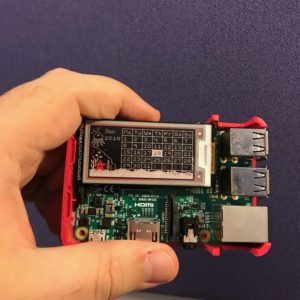A few quick thoughts on the Inky pHAT
Okay, I got it working. See!
But I had a number of really annoying problems, none of which really had to do with the hardware:
- I installed it on a Pi3 I had lying around that previously had been running my 3D printer using Octopi. I tried to do an “apt-get update” and “apt-get upgrade” so I could install the python modules, but it complained with some obscure error messages. Since I had a fresh img file of a more recent version of raspbian, I thought I’d just ignore the problem and shift to that.
- But, of course the computer gods hated me yesterday. It took a couple of tries for me to decide on using the latest Debian Stretch based distribution. I used the “lite” version without any desktop because, well, I could.
- I still had trouble doing an “apt-get upgrade”. For some reason, I couldn’t reach “mirrors.ocf.berkeley.edu”. I suspected something to do with nameservers, but couldn’t really track it down. I eventually hardcoded a different server into my /etc/apt/sources.list, and got it to update.
- I then had to install python-dev, which took a very long time, mostly because numpy takes forever to install.
- I then installed python-pip, without incident, and did a “pip install inky-phat”. That gave me an error while installing “Pillow”, caused by a missing dependency for libjpeg. I eventually figured I needed a “sudo apt-get install libjpeg-dev” and then reran the pip command.
- Then, for fun I cloned the git repository for the library so I would know where the examples are (after installing git of course) and then I could finally run their example code.
- Oh, except you need to run “raspi-config” to enable the SPI driver, or it won’t work.
Phew. All in all, a pretty frustrating time, but in the end it works well.
A couple of more comments.
When it was shipped to me, the “white” of the display seemed pretty yellow and not very pleasing, but after running the demo program, it refreshed pretty well, and the whites (while not exactly brilliant) are much better.
As you can tell by the picture above, the image remains visible even when power is completely disconnected which is kind of cool. But the reality is that the Pi is pretty slow to cold start and draws a lot of power, so having a low power display on the Pi isn’t actually as interesting as a similar display would be on a lower power board like the ESP32. But that being said, I really like the display.
I mounted it on Pi 3. The board has a 40 pin female header pack (2×20) on the back, which mates with the pins of the Pi3. If you have a Pi Zero W, you’ll probably need to solder a bunch of male pins on the board to mate up with it.
The case that I have for the Pi3 isn’t well suited for the combination, and won’t close. I might have to design and 3d print something.
I’ll try to write some code for it shortly.

I recall burning three or four weeks of a sabbatical getting Saccade.com on the air with Wordpress. So much tweaking…